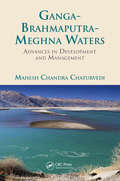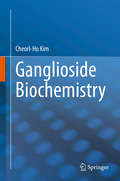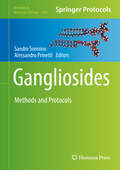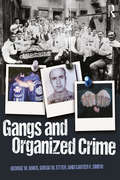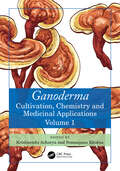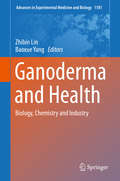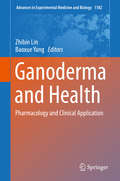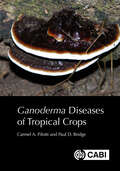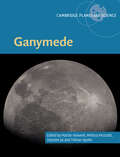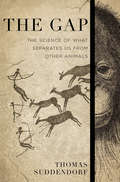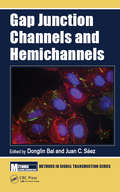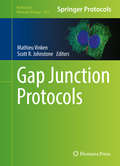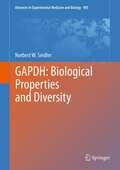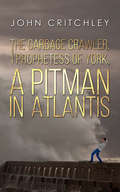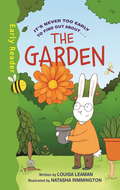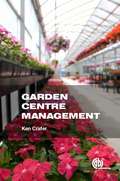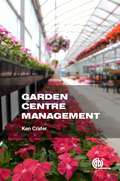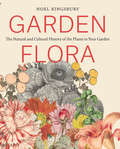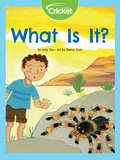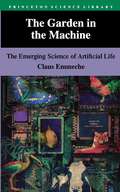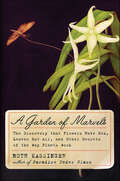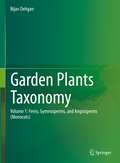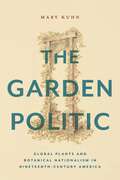- Table View
- List View
Ganga-Brahmaputra-Meghna Waters: Advances in Development and Management
by Mahesh Chandra ChaturvediOnce a prosperous region, the Ganga-Brahmaputra-Meghna (GBM) river basin-inhabited by about a tenth of the world's population-is currently one of the poorest. Large-scale socioeconomic development is urgently needed to ensure the sustainability of the region, and the management of water resources is a crucial part of this. Ganga-Brahmaputra-Meghna
Ganglioside Biochemistry
by Cheorl-Ho KimThis book presents the latest knowledge and the most recent research results in the field of ganglioside biochemistry. The early chapters cover all relevant background on sialic acids and their biosynthesis, on N-glycolylneuraminic acid (Neu5Gc), which cannot be synthesized by humans, and on general aspects of ganglioside research. Ganglioside adsorption, disorders of ganglioside degradation, and the regulation of gangliosides are thoroughly discussed. A major focus of the book is the role of gangliosides in cancer. Here, the discussion encompasses, for example, the biological importance, antigenicity, and immunological actions of tumor-associated gangliosides (TAGs), the significance of different glycolipids and gangliosides as TAGs, and emerging anti-cancer vaccine strategies. The ability of sialic acids and TAGs of tumor cells to escape immunosurveillance and immunoediting also receives detailed attention. The significance of sialic acids in regulation of the complement system is explained, and the closing chapter focuses especially on the role of sialyl T antigen in cancer. The book will be of value for all who are interested in functional glycobiology and glycomic studies.
Gangliosides: Methods and Protocols (Methods in Molecular Biology #1804)
by Sandro Sonnino Alessandro PrinettiThis detailed volume explores methods of examining gangliosides, membrane amphiphilic lipids that are deeply involved in the modulation of the overall properties of cellular membranes, as well as of the functions of membrane-associated proteins. The contents take into account the vital availability of new enzymatic approaches, the knowledge of an incredibly extensive number of glyco-enzymes, and the improvement of multi-genetic analyses. Written in the highly successful Methods in Molecular Biology series format, chapters include introductions to their respective topics, lists of the necessary materials and reagents, step-by-step, readily reproducible laboratory protocols, and tips on troubleshooting and avoiding known pitfalls. Authoritative and practical, Gangliosides: Methods and Protocols serves as a valuable guidebook for entering in the vast research world of gangliosides.
Gangs and Organized Crime
by George W. Knox Gregg Etter Carter F. SmithIn <i>Gangs and Organized Crime</i>, George W. Knox, Gregg W. Etter, and Carter F. Smith offer an informed and carefully investigated examination of gangs and organized crime groups, covering street gangs, prison gangs, outlaw motorcycle gangs, and organized crime groups from every continent. The authors have spent decades investigating gangs as well as researching their history and activities, and this dual professional-academic perspective informs their analysis of gangs and crime groups. They take a multi-disciplinary approach that combines criminal justice, public policy and administration, law, organizational behavior, sociology, psychology, and urban planning perspectives to provide insight into the actions and interactions of a variety of groups and their members. This textbook is ideal for criminal justice and sociology courses on gangs as well as related course topics like gang behavior, gang crime and the inner city, organized crime families, and transnational criminal groups. <i>Gangs and Organized Crime</i> is also an excellent addition to the professional’s reference library or primer for the general reader.
Gangs, Pseudo-Militaries, and Other Modern Mercenaries: New Dynamics in Uncomfortable Wars (International and Security Affairs Series #6)
by Max G. Manwaring Edwin G. Corr John T. Fishel<p>As the first decade of the twenty-first century has made brutally clear, the very definitions of war and the enemy have changed almost beyond recognition. Threats to security are now as likely to come from armed propagandists, popular militias, or mercenary organizations as they are from conventional armies backed by nation-states. In this timely book, national security expert Max G. Manwaring explores a little-understood actor on the stage of irregular warfare—the gang. <p>Since the end of the Cold War, some one hundred insurgencies or irregular wars have erupted throughout the world. Gangs have figured prominently in more than half of those conflicts, yet these and other nonstate actors have received little focused attention from scholars or analysts. This book fills that void. <p>Employing a case study approach, and believing that shadows from the past often portend the future, Manwaring begins with a careful consideration of the writings of V. I. Lenin. He then scrutinizes the Piqueteros in Argentina, gangs in Colombia, private armies in Mexico, Hugo Chavez's use of popular militias in Venezuela, and the looming threat of Al Qaeda in Western Europe. <p>As conventional warfare is increasingly eclipsed by these irregular and “uncomfortable” wars, Manwaring boldly diagnoses the problem and recommends solutions that policymakers should heed.</p>
Ganoderma: Cultivation, Chemistry and Medicinal Applications, Volume 1
by Krishnendu Acharya Somanjana KhatuaGanoderma holds significant traditional importance in various ethnic cultures around the world, particularly in China, Japan, and Korea. Many indigenous traditions have incorporated Ganoderma into medicinal practices, being considered a symbol of longevity, vitality, and good health. At present, the taxon is believed to possess various health benefits and is used to treat ailments and promote overall well-being. In this context, the first volume of the book, titled Ganoderma: Cultivation, Chemistry and Medicinal Applications, aims to comprehensively cover the taxonomy, morphological features, domestication strategies, structures of secondary metabolites, and therapeutic prospects of Ganoderma. It may serve as a definite resource for students, researchers, healthcare professionals, traditional medicine practitioners, and enthusiasts.FEATURES Provides a comprehensive classification system for Ganoderma species, highlighting their taxonomy and distinguishing characteristics Delves into the techniques and practices involved in cultivating Ganoderma, offering detailed guidance for individuals interested in growing this valuable fungus Explores the cultural and traditional significance of Ganoderma in various ethnic cultures intertwined with customs, beliefs, rituals, myths, and folklore around the world Investigates the secondary metabolites of Ganoderma, highlighting their implications Examines diverse bioactivities associated with Ganoderma, including antioxidant, hepatoprotective, antidiabetic, prebiotic, anti-inflammatory, anti-arthritis, anticancer, hypolipidemic, and cholesterol-lowering effects This book includes relevant illustrations, diagrams, and images to enhance the understanding of concepts associated with Ganoderma.
Ganoderma and Health: Biology, Chemistry and Industry (Advances in Experimental Medicine and Biology #1181)
by Zhibin Lin Baoxue YangThis book presents a state-of-the-art report on recent advances concerning Ganoderma and where the field is going. Although some older work is also cited, the main focus is on advances made over the past 20 years in the research history, classification, chemical components and industry of Ganoderma. Ganoderma lucidum (Lingzhi) has been used as a traditional medicine in Asian countries to maintain health and to treat diseases for more than two thousand years. Recently, its value has been demonstrated in preventing and treating certain diseases, such as tumors, liver disorders, renal injury, hypercholesterolemia, obesity, cerebral ischemia reperfusion, bronchitis etc. In addition, laboratory and clinical studies have confirmed that the chemical components of Ganoderma, such as Ganoderma lucidum polysaccharide peptides and triterpenes isolated from the fruiting body of Ganoderma lucidum, produce diverse pharmacological effects. Ganoderma and its components play an important part in antioxidant stress, radical-scavenging, immunomodulation, and intracellular signaling regulation, and accordingly warrant further study. This book systematically reviews the latest advances in our understanding of Ganoderma’s basic knowledge, history of modern research, species, cultivation, components, spore polysaccharide and industry of Ganoderma, and offers researchers and graduate students valuable new insights into the development and clinical applications of Ganoderma and related products.
Ganoderma and Health: Pharmacology and Clinical Application (Advances in Experimental Medicine and Biology #1182)
by Baoxue Yang Zhibin LinThis book presents a state-of-the-art report on recent advances concerning Ganoderma and where the field is going. Although some older work is also cited, the main focus is on advances made over the past 20 years in the pharmacology and clinical applications of Ganoderma.Ganoderma lucidum (Lingzhi) has been used as a traditional medicine in Asian countries to maintain health and to treat diseases for more than two thousand years. Recently, its value has been demonstrated in preventing and treating certain diseases, such as tumors, liver disorders, renal injury, hypercholesterolemia, obesity, cerebral ischemia reperfusion, bronchitis etc. In addition, laboratory and clinical studies have confirmed that the chemical components of Ganoderma, such as Ganoderma lucidum polysaccharide peptides and triterpenes isolated from the fruiting body of Ganoderma lucidum, produce diverse pharmacological effects. Ganoderma and its components play an important part in antioxidant stress, radical-scavenging, immunomodulation, and intracellular signaling regulation, and accordingly warrant further study. This book systematically reviews the latest advances in our understanding of pharmacology and clinical applications of Ganoderma, and offers researchers and graduate students valuable new insights into the pharmacology and clinical applications of Ganoderma and related products.
Ganoderma Diseases of Tropical Crops
by Dr Carmel A Pilotti Paul BridgeThe fungal genus Ganoderma includes around 80 currently recognized species that are widely distributed in temperate, subtropical and tropical regions, and cause disease in a range of economically important perennial crops and tree-like plants. Ganoderma root and lower stem rots have a significant impact on yields from crops including oil palm, coconut, beverage crops, Acacia and rubber. The identification of species responsible for stem and butt rots is often ambiguous as closely related species may only be distinguished by subtle morphological differences. Within species there can be considerable morphological plasticity and this can make morphology-based identification difficult, particularly for species described from a single specimen. Molecular techniques are helping to slowly resolve Ganoderma taxonomy but it will be some time (if ever) before the taxonomy is fully resolved. This book brings together information on Ganoderma species that are reported to be responsible for crop diseases in tropical and sub-tropical agriculture and covers taxonomy, biology, genetics, aetiology, epidemiology and control. This book is an essential resource for researchers in Ganoderma in crop science and tropical agriculture, as well as practitioners and industry.
Ganymede (Cambridge Planetary Science)
by Martin Volwerk, Melissa Mcgrath, Xianzhe Jia and Tilman SpohnWith ESA's upcoming JUpiter ICy moons Explorer (JUICE) mission to Jupiter and Ganymede, this book provides a fascinating and timely summary of our current knowledge about Ganymede: the largest moon in the Solar System and the only one with an intrinsic magnetic field. Written by a team of multidisciplinary experts spanning geology, space physics and habitability, it provides up-to-date knowledge about Ganymede. The history of its discovery, formation, surface, atmosphere and space environment are discussed in accessible language and supported by the enormous amount of data obtained by Galileo, the Hubble Space Telescope and earlier missions. The latest surface maps of Ganymede are also presented, providing an invaluable reference for graduate students and researchers working in planetary science.
Ganzkörper-Elektromyostimulation: Effekte, Limitationen, Perspektiven einer innovativen Trainingsmethode (essentials)
by Wolfgang Kemmler Michael Fröhlich Christoph EiflerDas vorliegende Essential versteht sich als kompaktes Nachschlagewerk für Fragen und Aspekte rund um die innovative Trainingstechnologie Ganzkörper-Elektromyostimulation (WB-EMS). Neben Hintergründen und Informationen zur WB-EMS Applikation, bei der die Autoren besonderes Augenmerk auf die sichere und effektive Anwendung legen, erfolgt eine aktuelle Übersicht über Forschungsergebnisse, welche die Effekte von WB-EMS auf unterschiedliche Zielgrößen zusammenfasst. Abschließend wird eine Charakterisierung der Marksituation sowie derzeitiger Trends und eine Prognose von Entwicklungen im Spannungsfeld WB-EMS vorgelegt.
The Gap: The Science of What Separates Us from Other Animals
by Thomas SuddendorfThere exists an undeniable chasm between the capacities of humans and those of animals, but what exactly is the difference between our minds and theirs? In "The Gap," psychologist Thomas Suddendorf provides a definitive account of what makes human minds unique and how this disparity arose. He proposes that two innovations account for all of the ways in which our minds appear so distinct: our open-ended ability to imagine and reflect, and our insatiable drive to link our minds together. It is not language or morality that set us apart, but the ability to consider a range of scenarios, real and imagined, past and future. A provocative argument for reconsidering our place in nature, "The Gap" is essential reading for anyone interested in our evolutionary origins and our relationship with the rest of the animal kingdom.
Gap Junction Channels and Hemichannels (Methods in Signal Transduction Series)
by Donglin Bai Juan C. SáezGap junction channels are a group of intercellular channels expressed in tissues and organs to synchronize many physiological processes. A gap junction channel is formed by the docking of two hemichannels, and each hemichannel is a hexamer of connexins. The field of gap junction channel and hemichannel research has recently exploded and became one of the most active areas of cell biology. Numerous novel approaches and techniques have been developed, but there is no single book dedicated to the unique techniques and protocols employed for the research on these large pore channels. This book fills the gap and focuses on protocols, approaches and reviews of gap junction channels and connexin hemichannels. It will be a useful reference for graduate students, postdoctoral fellows and researchers. Anyone with an interest in gap junction channels and hemichannels will need this summary of state-of-the-art techniques and protocols.
Gap Junction Protocols
by Mathieu Vinken Scott R. JohnstonePresenting state-of-the-art protocols to study gap junctions, this detailed book first focuses on the use of methods and tools to investigate the different aspects of connexin expression and gap junction regulation. The second part of the volume describes several methods to probe gap junction functionality as such. Written in the highly successful Methods in Molecular Biology series format, chapters include introductions to their respective topics, lists of the necessary materials and reagents, step-by-step and readily reproducible laboratory protocols, and key tips on troubleshooting and avoiding known pitfalls. Authoritative and practical, Gap Junction Protocols is intended for basic and applied researchers in the area of biomedical and life sciences, both in academic and industrial settings.
GAPDH: Biological Properties and Diversity
by Norbert W. SeidlerThe book represents a comprehensive review and synthesis of the biomedical literature that spans over a half-century on a single protein called glyceraldehyde 3-phosphate dehydrogenase (or, GAPDH). Due to the protein's involvement in a vast array of cellular activities, GAPDH is of interest to the cell biologist, immunologist, virologist, biochemist etc. The protein has a significant role in fertility, cancer and neurodegeneration, suggesting that this book can be a vital resource for drug development. GAPDH function may provide insight into anesthesia. Furthermore, GAPDH is highly conserved meaning that the protein found in microorganisms, such as pathogens, remained relatively unchanged in evolution. Pathogens use GAPDH as a virulence factor, offering a unique challenge in developing anti-microbial agents that target this protein. To the evolutionary biologist, a book on the multi-functionality of GAPDH provides a focal point for a cogent discussion on the very origin of life.
The Garbage Crawler, The Prophetess of York, A Pitman in Atlantis
by John CritchleyThe Garbage Crawler, The Prophetess of York, A Pitman in Atlantis are an enthralling trio of plays set for the radio and the stage, concerning myth, legend and science fiction. In The Garbage Crawler, we find Zachery, who has only ever known his room and the robotic voice that controls his life. He escapes into a sea of rat-infested, foul-smelling garbage through a chute, where he is discovered by a Finder. His destiny and that of the city he comes to come into question as he becomes a Finder himself and looks to liberate the city. Set in York in 1833, The Prophetess of York is 19-year-old Hannah Beedham, a self-professed 'common sinner'. She experiences a glorious vision of God himself, but the people of York denounce her as a drunk and a witch. However, local man James Sturdy believes her, as do some from all over who pay tribute to the 'Prophetess'. A Pitman in Atlantis sees John Bell fall from a sea defence wall in Yorkshire and wake up in a foreign hospital, only to find he has landed in Atlantis. He begins working in a silver mine in the underwater city while fellow Englishmen work to try and find a way for John to return to his wife and the world on the surface.
The Garden (Early Reader Non Fiction)
by Louisa LeamanEarly Readers are stepping stones from picture books to reading books. A green Early Reader is a first factbook.It's never too early to find out about... The Garden.Bugs and beetles, birds and plants, there's a world to be discovered and it's right on your doorstep. Beautifully illustrated in full colour on every page, this new Early Reader will show you the amazing possibilities of the great outdoors!
Garden Centre Management
by Ken CraferGarden Centre management has professionalised in recent years as garden centres have become more highly developed retail operations. Many students of horticulture are expected to go into retail management and so the topic has increasingly appeared on the further education curriculum. This book is equally targeted at students, garden centre managers and professional courses in garden centre management. It provides a practical approach backed up by management theory. The text covers consumer behaviour, staff management, stock management, marketing and productivity.
Garden Centre Management
by Ken CraferGarden Centre management has professionalised in recent years as garden centres have become more highly developed retail operations. Many students of horticulture are expected to go into retail management and so the topic has increasingly appeared on the further education curriculum. This book is equally targeted at students, garden centre managers and professional courses in garden centre management. It provides a practical approach backed up by management theory. The text covers consumer behaviour, staff management, stock management, marketing and productivity.
Garden Flora: The Natural and Cultural History of the Plants In Your Garden
by Noel Kingsbury“A beautifully illustrated reference book covers the origins, ecology and history of popular garden plants.” —Shelf Awareness The oldest rose fossil was found in Colorado and dates to 35 million years ago. Marigolds, infamous for their ability to self-seed, are named for an Etruscan god who sprang from a ploughed field. And daffodils—an icon of spring—were introduced to Britain by the Romans more than 2,000 years ago. Every garden plant has an origination story, and Garden Flora, by noted garden designer Noel Kingsbury, shares them in a beautifully compelling way. This lushly illustrated survey of 133 of the most commonly grown plants explains where each plant came from and the journey it took into home gardens. Kingsbury tells intriguing tales of the most important plant hunters, breeders, and gardeners throughout history, and explores the unexpected ways plants have been used. Richly illustrated with an eclectic mix of new and historical photos, botanical art, and vintage seed packets and catalogs, Garden Flora is a must-have reference for every gardener and plant lover.
Garden Guesthouse: Is It What Jesus Intended?
by Nancy Cote Amy TaoHave you ever heard of a bug hotel? There are some insects that help plants by spreading pollen and improving the soil, but they don’t always show up in every garden. To help encourage them to move in, some gardeners build little houses for them!
The Garden in the Machine: The Emerging Science of Artificial Life (Princeton Science Library #121)
by Claus EmmecheWhat is life? Is it just the biologically familiar--birds, trees, snails, people--or is it an infinitely complex set of patterns that a computer could simulate? What role does intelligence play in separating the organic from the inorganic, the living from the inert? Does life evolve along a predestined path, or does it suddenly emerge from what appeared lifeless and programmatic? In this easily accessible and wide-ranging survey, Claus Emmeche outlines many of the challenges and controversies involved in the dynamic and curious science of artificial life. Emmeche describes the work being done by an international network of biologists, computer scientists, and physicists who are using computers to study life as it could be, or as it might evolve under conditions different from those on earth. Many artificial-life researchers believe that they can create new life in the computer by simulating the processes observed in traditional, biological life-forms. The flight of a flock of birds, for example, can be reproduced faithfully and in all its complexity by a relatively simple computer program that is designed to generate electronic "boids." Are these "boids" then alive? The central problem, Emmeche notes, lies in defining the salient differences between biological life and computer simulations of its processes. And yet, if we can breathe life into a computer, what might this mean for our other assumptions about what it means to be alive? The Garden in the Machine touches on every aspect of this complex and rapidly developing discipline, including its connections to artificial intelligence, chaos theory, computational theory, and studies of emergence. Drawing on the most current work in the field, this book is a major overview of artificial life. Professionals and nonscientists alike will find it an invaluable guide to concepts and technologies that may forever change our definition of life.
A Garden of Marvels: How We Discovered that Flowers Have Sex, Leaves Eat Air, and Other Secrets of Plants
by Ruth KassingerIn the tradition of The Botany of Desire and Wicked Plants, a witty and engaging history of the first botanists interwoven with stories of today’s extraordinary plants found in the garden and the lab.In Paradise Under Glass, Ruth Kassinger recounted with grace and humor her journey from brown thumb to green, sharing lessons she learned from building a home conservatory in the wake of a devastating personal crisis.In A Garden of Marvels, she extends the story. Frustrated by plants that fail to thrive, she sets out to understand the basics of botany in order to become a better gardener. She retraces the progress of the first botanists who banished myths and misunderstandings and discovered that flowers have sex, leaves eat air, roots choose their food, and hormones make morning glories climb fence posts. She also visits modern gardens, farms, and labs to discover the science behind extraordinary plants like one-ton pumpkins, a truly black petunia, a biofuel grass that grows twelve feet tall, and the world's only photosynthesizing animal. Transferring her insights to her own garden, she nurtures a "cocktail" tree that bears five kinds of fruit, cures a Buddha's Hand plant with beneficial fungi, and gets a tree to text her when it's thirsty.Intertwining personal anecdote, accessible science, and untold history, the ever-engaging author takes us on an eye-opening journey into her garden—and yours.
Garden Plants Taxonomy: Volume 1: Ferns, Gymnosperms, and Angiosperms (Monocots)
by Bijan DehganHorticulture has remained far behind in understanding of botanical principles. Recent phylogenetic (DNA-based) reorganization of higher plants has revolutionized taxonomic treatments of all biological entities, even when morphology does not completely agree with their organization. This book is an example of applying principals of botanical phylogenetic taxonomy to assemble genera, species, and cultivars of 200 vascular plant families of ferns, gymnosperms, and angiosperms that are cultivated for enhancement of human living space; homes, gardens, and parks. The emphases are on cultivated species but examples of some plants are often shown in the wild and in landscapes. In providing descriptions, it is assumed that students and other interested individuals have no background in general botany (plant characteristics), or nomenclature. Fundamental features of all plant groups discussed are fully illustrated by original watercolor drawings or photographs. Discussion of the families is grounded on recent botanical phylogenetic treatments, which is based on common ancestry (monophyly). Of course, phylogenetic taxonomy is not a new concept, and was originally based on morphological characteristics; it is the DNA-based phylogeny that has revolutionized modern biological classifications. In practical terms, this book represents the horticultural treatment that corresponds to phylogenetic-based botanical taxonomy, to which is added cultigens and cultivated genera and species. Hence, the harmony between horticultural and botanical taxonomy. This book covers phylogenetic-based taxonomy of Ferns, Gymnosperms, and Angiosperms (Monocots). A companion volume covers Angiosperms (Eudicots).
The Garden Politic: Global Plants and Botanical Nationalism in Nineteenth-Century America (America and the Long 19th Century #27)
by Mary KuhnHow worldwide plant circulation and new botanical ideas enabled Americans to radically re-envision politics and societyThe Garden Politic argues that botanical practices and discourses helped nineteenth-century Americans engage pressing questions of race, gender, settler colonialism, and liberal subjectivity. In the early republic, ideas of biotic distinctiveness helped fuel narratives of American exceptionalism. By the nineteenth century, however, these ideas and narratives were unsettled by the unprecedented scale at which the United States and European empires prospected for valuable plants and exchanged them across the globe. Drawing on ecocriticism, New Materialism, environmental history, and the history of science—and crossing disciplinary and national boundaries—The Garden Politic shows how new ideas about cultivation and plant life could be mobilized to divergent political and social ends. Reading the work of influential nineteenth-century authors from a botanical perspective, Mary Kuhn recovers how domestic political issues were entangled with the global circulation and science of plants. The diversity of Harriet Beecher Stowe’s own gardens contributed to the evolution of her racial politics and abolitionist strategies. Nathaniel Hawthorne’s struggles in his garden inspired him to write stories in which plants defy human efforts to impose order. Radical scientific ideas about plant intelligence and sociality prompted Emily Dickinson to imagine a human polity that embraces kinship with the natural world. Yet other writers, including Frederick Douglass, cautioned that the most prominent political context for plants remained plantation slavery. The Garden Politic reveals how the nineteenth century’s extractive political economy of plants contains both the roots of our contemporary environmental crisis and the seeds of alternative political visions.
